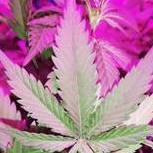Leaderboard
Popular Content
Showing content with the highest reputation on 06/08/2019 in all areas
-
Today we begin the 5th week of flower. Day 29. Plant is looking gorgeous, I opened her up for some natural light to photograph a bit for an update.4 points
-
the somber day has come where i need to take a life slowly and painfully chopping of limbs over a week or so i have dawned my ritual murder garbs and had a healthy vegan biltong snack its been a long journey 8 months of which was 16 weeks was flowering i gave it sea grow twice i think during veg and during flower i only gave it seed sprout tea made from popcorn seeds and mung bean every week and a half and skipped when it rained i dont know how i only got one vote in the plant of the month comp because i think a 3.5m tree is quite impressive but lets wait to see the yield3 points
-
The Plug Seeds - Spumoni This one I got as a freebie from Amsterdam Seed Centre. It is a cross between Dosi-do and Sunset Sherbet. I know how the fuck did they come up with this name? It is planted in a home made mix of organic soil. Will be growing her indoors under a combination of LED's and Metal Halides. Sent from my VTR-L09 using Tapatalk2 points
-
This is a good read, thought I would also share it here, a very long version (tips from various sources) is in the Breeders Group if you find this interesting. Happy growing 420SA! Breeding tips:How to bring out the Sativa and breed the ultimate buds.To understand the principles behind the breeding of cannabis you first need to be familiar with some basic terms related to genetics. "Genotype" is the genetic and chromosomal make-up of any given individual — it is the genetic code. "Phenotype" is the expression of body type, structure, and appearance of individuals; it results from the interaction between genotype and environment.Specific environmental conditions are often required for certain phenotypic expressions from a given genotype. If the available nutrients, hours of sunlight, or other conditions are not available then the development of the plant or animal will be altered. These conditions are referred to as "environmental triggers."Two individuals with the same genotype can have greatly different phenotypes if grown in different environments.Indoor vs outdoorIn terms of growing and breeding cannabis, there is a distinct difference between indoor and outdoor grow environments. No matter where on the planet one is, the indoor environment is usually far more limited when compared to the spectrum of conditions existing outdoors.When compared to the wide variety of conditions available outdoors, the indoor environment may be seen as relatively bland and generic. The greenhouse environment, especially when fortified with electric light, is perhaps the closest thing available to a happy marriageThree subspeciesIt is useful to agree, at least in theory, that there are three separate subspecies of the genus Cannabis — Sativa, Indica and Ruderalis.Cannabis Sativa is the equatorial variety found primarily around 30 degrees latitude North or South. Sativa generally grow tall, from seven to thirty feet, have many long branches, narrower leaflets, and mature slowly.Cannabis Indica varieties generally inhabit the areas between 30-50 degrees North or South latitude. Indica are generally much shorter than Sativa, only about three to five feet tall. They have fewer and shorter branches than Sativa, the longer of which are lower on the plant, with much wider leaflets. They also mature earlier and more rapidly than Sativa.Cannabis Ruderalis grow naturally primarily past 50 degrees north latitude (the Siberian steppes). Ruderalis are the shortest, least bushy, and fastest maturing of the three.The end of the sweet spotsPrior to the late 1970's, virtually all commercially available cannabis products came from the great outdoors. Many of these varieties had been grown in their particular region since antiquity — not since the advent of sailing had a greater diversification and distribution of the herb occurred.Most cannabis available was also very well acclimated to its particular region of origin. Certain places tended to produce very unique and desirable types of herb that were renowned to each region. I like to refer to these high-quality cannabis producing areas as "sweet spots." The products coming out of these sweet spots during this era were among the finest herbs ever available.A series of phenomena occurred in the late 1970's and early 80's that has since revolutionized the cannabis industry. This series included the triad of sinsemilla, High Intensity Discharge (HID) lighting, and the introduction of Indica genetics, coupled with draconian herb laws that drove the industry far underground. Never before in human history was so much genetic diversity of cannabis grown in such generic, indoor conditions. The results of this phenomenon have wreaked havoc on the cannabis gene pool.The road to blandnessAs Indica, sinsemilla and HID lighting became predominant, it became apparent that Sativa varieties were very difficult to coax commercial amounts of sinsemilla herb from indoors. The fast maturing, dense bud structure of the easy-to-grow Indica soon dominated the indoor grow scene.Another factor contributing to the desirability of the indoor Indica was its truebreeding "dioecious" nature, meaning that individual plants tend to be male or female only, but not both. In contrast, many Sativa strains show hermaphroditic tendencies indoors, with male and female flowers on the same plant. (It is my opinion that wild Sativa strains of cannabis are primarily truebreeding hermaphroditic varieties.)As outdoor production diminished due to intolerant laws and the drug war, indoor production of Indica phenotypes became the staple of the commercial indoor grower. The road to generic blandness had begun.Although some Sativa/Indica crosses matched some of the Sativa flavor and head high with the Indica bud structure, this desirability would only last for a few generations of breeding. Unless a person is breeding for a very specific trait, crosses seven generations and beyond the original P1 Indica/Sativa cross lose much of their original charm and desirability. Cloning, however, helps to extend a given plant's potential.Ruderalis: myth and misnomerAs indoor growers attempted to improve their genetic lines via breeding, another interesting phenomenon occurred: Ruderalis. Although there is a wild variety identified as Ruderalis in Russia ("Ruderalis" is supposedly Russian for "by the side of the road") that grows very short and matures very fast, I seriously doubt the rumor that someone actually went to Russia to collect seeds of this variety sometime in the past. Or, if someone actually did go all the way to Russia to find, collect and smuggle "rudy" seeds, I do feel sorry for their waste of time. They could have gotten the same worthless thing from Minnesota, Saskatchewan or Manitoba with much less hassle.The North American Ruderalis probably originated as follows: After the Indica varieties arrived in the US and became incorporated into the gene pool, many breeders began to cross the earliest maturing individuals with each other in hopes of shortening the maturation cycle.It would only take a few generations for the ugly Rudy phenotypes to begin expressing themselves. By ugly, I am referring to a strong lack of potency and/or desirability. I know, I was once guilty of the practice myself. It did not take me long to realize that this was a huge mistake in regard to the quality and potency of the future generations' finished product, and all subsequent breeding along this line was ceased.Many of these manipulated rudies were released on the open market between 1981 and 1986. It was shortly after this period that the grow journals of the era (Sinsemilla Tips and High Times) ran articles about the possibility of a new wonder variety for indoor grows: fast blooming Ruderalis. Rumor had spread to myth and misnomer. Therefore, it may be more appropriate to say that the Ruderalis phenotype was coaxed from Indica genetics, via the indoor breeding environment.The same applies to many of the Indica dominant varieties available today. Breeders selecting for early, fast flowering or fast growth often miss out on some of the finer and more subtle characteristics available from crossing certain genotypes. My advice to breeders is to wait until the finished product is suitably tested before coming to any conclusions regarding desirable candidates for future breeding consideration.Phenotypic expressionThe malleability of phenotypic expression among the Sativa/Indica crosses must also be noted. The variability of phenotypic expression among the f2 generation of a truly polar (pure Sativa/pure Indica) P1 cross is quite phenomenal. The second generation f2 crosses will exhibit the full spectrum of possibilities between the original parents — extreme Indica, extreme Sativa, and everything in between.However, regardless of any particular phenotype selected from among this given f2 cross, future generations may drift radically. Depending on the presence (or lack) of a number of environmental triggers, an f2 Indica phenotype may be coaxed more toward Sativa traits, or an f2 Sativa phenotype may be coaxed more toward Indica expression. The key is environmental conditions.This is what distinguishes the truebreeding, ancient acclimated, region of origin varieties — especially the tropical and equatorial Sativa — from the crosses that have happened since. The ancient specimens have a much narrower genotype range, and therefore a more specific phenotype than their contemporary crosses despite environmental conditions. It is up to future adventurers to provide the best possible environmental considerations, along with the best possible genetic considerations, in order to resurrect the legendary happy flowers of yore.Inducing SativaAfter many years of first-hand experience breeding herb indoors as well as outdoors, I am of the opinion that the two most influential factors involving phenotypic variation and expression among current indoor herb breeding projects are the photoperiod (hours of light per day) and the angle of light in relationship to the growing plant.Specifically, I find the single most powerful influence to the Indica dominant phenotype is the traditional 18/6 veggie cycle and 12/12 flowering cycle. The 18/6 veggie and 12/12 flower cycle is an attempt, however poor, to mimic the Indica-producing photoperiod. It is my belief that this light cycle strongly influences for Indica phenotypic expression.Sativa phenotype characteristics will manifest under a more equatorial photoperiod, closer to a 13/11 veggie cycle and an 11/13 flower cycle. This is the light timing range to use to elicit more Sativa dominant expression from your plants.As for the exact photoperiod formula that I incorporate into my growing/breeding regime, this will presently remain a trade secret. My advice is to experiment with different photoperiods, keep good notes and pay attention. Avoid the 18/6 and 12/12 photoperiods, while tweaking the times a bit differently with each breeding cycle until more desirable results in the finished product and their offspring are noted. Here's a hint: work in half-hour increments or a little less, and good luck!Angle of LightAngle of light simply refers to the physical angle of light source the plant is dependent upon for growth. Perhaps the greatest difference between indoor and outdoor environments has to do with the angle of light received by the plant. This is also one of the greatest seasonal differences between the Sativa and Indica producing regions.Outdoors, the main light source is the Sun, with minor influence coming from nearby reflective surfaces. As a plant grows taller and broader outdoors, that angle of light from the sun changes very little in relationship to the growing plant.Seasonal changes in angle of light increase the further away from the equator one gets. At the equator there is the least amount of seasonal change in angle of light, only about 20°, whereas at the 45th parallel that change is as great as 45°. At the 45th latitude, the Summer Sun is high in the sky while during early Spring and late Fall the sunlight comes from much lower in the sky. The farther one goes from the equator, the greater the difference in seasonal changes regarding angle of light.Indoors, the lights typically range from a few inches to several feet from the plant. As the plant grows taller, its physical relationship to the bulb's angle of light changes considerably. Most indoor grow rooms have relatively low ceilings, therefore, raising the bulbs may maintain a similar angle of light early on, but eventually the angle changes. The same differences may be noted among plants directly below the bulb and the plants off to the side of the room farther away from the bulb.Circular light shuttles tend to emulate the arctic summer and create a confusing signal completely unknown to the equatorial Sativa. Straight-track overhead light shuttles are more conducive to inducing the Sativa phenotype.Aromatics and flavorsMany indoor growers try to get their budding plants as close to the light source as possible. Though this may increase bulk production of both bud and trichome, I find that this practice tends to destroy many of the finer aromatic qualities of the herb.Buds too close to the light tend to express nothing beyond the lower lemon/lime aromas of the fruity spectrum. Sometimes the aroma is no better than a strong chemical/astringent odor and flavor, especially those under High Pressure Sodium light systems. The finer berry flavors tend to favor more distance from the bulb, and will manifest more strongly under High Ultraviolet Metal Halide light systems, especially during the latter stages of flowering.Something akin to a gymnasium building with high ceilings and super 5000W lights hung far from the growing plants, set at a Sativa-tweaked photoperiod, would be the ultimate indoor grow-op to coax Sativa phenotypes.Sweet spot fantasyNothing will ever rival the great outdoor sweet spots for quality cannabis production. Hopefully, someday, somewhere, someone will be daring and lucky enough to get away with re-establishing some of the great genetic lines in their specific region of origin sweet spots.Equatorial Sativa varieties are of interest for quality herb production (Thailand, Oaxaca, Colombia, Central Africa, etc.) as the Indica zones are more renowned for hashish production. Parts of Nepal tend to produce both excellent hashish and fine Sativa buds, with some plants reportedly living longer than two years!I hope that I am able to live long enough to once again experience the joy associated with the fine herbal products from the great regional sweet spots of near ancient lore. It has been a long time and I am looking forward to the day.by DJ Short2 points
-
Took a measurement again this afternoon when prepping water. Tap water around 7.3 and around 7 after adding nutes. Only a few drops of lime to bring it to 6.5.... Sent from my CLT-L29 using Tapatalk2 points
-
Very interesting reading. Thanks for sharing@Dank. Sent from my SM-A500F using Tapatalk2 points
-
1 point
-
Not sure about the other one, but colloidal silver is sprayed on the female as it goes into flower every day either for a set period or until you see male flowers appear. So very easy to do.1 point
-
I'd like to play around with that and getting some fem seeds at some point, best I get some of those chems. How do you use the chemicals? Sent from my Redmi Note 7 Pro using Tapatalk1 point
-
These are the chemicals, and none of my Girl Scout Cookies has ever thrown hermies for me (and I've had light leaks before).1 point
-
Shot, Yeah man, definitely appreciate the advice. Through implementation and patience she is keeping up her end of the bargain for sure.1 point
-
Just read the whole thread your flowers are looking beautiful @LukeS , great advice from the forum members.1 point
-
@PsyCLown most of the feminized seed people buy have a good chance to go hermie if you give them enough stress. That is also true for any Cannabis plant, however a regular seed from a hybrid or landrace will be able to withstand more stress, even need some chemicals applied to induce male flowers on the female plants. There are quite a few methods breeders use to produce female only seeds. In the end this will all strengthen the hermie trait (just my opinion) in that particular strain. Cookies is a good example of too many s1 crosses. It makes the trait more dominant instead of recessive. EDIT: About mutants, they are usually sought afterin breeding projects for higher thc, bigger buds, things like that, having more chromosomes than a normal cannabis plant. AKA Polyploid1 point
-
You can create mother plants from clones, however some growers prefer to keep their mother plant that was grown from seed. Pollen that comes from a male flower on a female plant will have no male chromosomes and will produce female offspring. The next generations will become hermaphrodite a lot easier if plants get stressed, etc.1 point
-
I see, so if you force a hermie and then have another female and use the hermie to pollinate the hermie will that reduce the chances of those seeds turning into hermes easily? Sent from my Redmi Note 7 Pro using Tapatalk1 point
-
1 point
-
@highjinx Thanks for reply... yeah space is an issue for me to, that why I just take clones from the girls b4 they go into flower.... Cannot see a reason to keep a permanent mother plant.1 point
-
1 point
-
1 point
-
1 point
-
If this is what we are growing in the grow offs, our lives will be complete... is this what we are growing?1 point
-
All dried and ready for the cure. Both plants delivered in excess of 750g each. It has been a pleasure to bring you that are following this log. It is still frightening at times to post to a practically public platform a tiny piece of my passion for plants. I have however realised that as much as this log has been incriminating, it has also been an example of how benign it is to grow cannabis. None of my neighbors bled or died as a result of my plants. I breed pepper plants too and spend more time with them than any other species. The point is. Here it is...the seeds went into soak on the day the Constitutional Court made the verdict, and an entire baby later, yes almost 6 months of veg and just over 3 months of flower, I am consuming my own non criminal cannabis, and this log is proof of where my Cannabis has come from. Start a grow log. Not entirely for our benefit but for your own. This revolution has long gained traction but having a log like this one is powerful, factual evidence that you are growing your own Cannabis and you can fully account since seed/clone. But really...we have had to live in the dark with this forever...Let's show them how we do it like the productive normal people we are. To put costs of this grow into perspective. I spent a total of R200 on fertilizer. My soil mix cost me R400. Water was R30 x 9 months, so R180. For a total of under a grand spent, that works out to about R1 to R1,50 a gram. This changes everything. This improves my life. This, well this! That gives myself and my wife 2g a day until I can grow and harvest again 12 months from now.1 point
-
Respect.. Was a good one to follow.. Setting the standard right up there for the grow off..1 point
-
So i am thinking to flip this girl, wondering if i should first transplant into a 40l pot before flowering? soil drying very quickly now, but when i watered the other day got behavior of over watering so just needs to be managed.1 point
-
1 point
-
Or...since you are doing the organic thing. Chuck the lemon, bicarb, ph pen and all and just use tap water, aged for a day and nutes added. I havent checked pH for years. Really not necessary with organics. The microbes create the pH they want to live in.1 point
-
Since your using organic nutes, don't buy the pH up and pH down at the hydro shop. That's for synthetic nutes. Buy yourself some lemon juice at PnP for pH down and buy Bicarb Soda, the blue box also at PnP for pH up. The pH up and down kills off your beneficial bacteria in the soil Sent from my G3312 using Tapatalk1 point
-
Sup Luke, so initially reading I thought you might have gotten stress since moving the plant under the bigger light. However you NEED to feed freedom soil. The whole "organic" topic of freedom soil is a bit iffy. Outdoor you add a bunch of shit like worms, teas, no till. Indoor however is different, you have to feed every watering. PH the feed to 5.2-5.8. BioGrow is good for an all round veg and flowering feed, FishMix from BioBizz is lekka for vegging. Get some BioBloom for flowering. Also invest in some MicroLife, Humic and Fulvic acids from Freedom farms. In terms of the mildew, don't feel bad I'm also having that kak atm but bought AQ-SP from JamieSoil out in Somerset. Neem is also good to buy, although it smells like sharts. I don't see an oscillating fan in that tent?? You'd want to add one of those bad boys too. Let me know if you have any other questions. We're all here to help each other. Another tip for feeding, print yourself out an A4 calendar for the month, you know the one that you can write on. Good for tracking feed, pH and also how old your girls are. Sent from my G3312 using Tapatalk1 point
-
In place and hanging. Now that I have a workaround for loadshedding, watch me not get loadshedded Sent from my EVA-L09 using Tapatalk1 point
-
That is brilliant, i've done research on plants that effect the soil around your cannabis but never dug deep to find out what other plants can do for cannabis above ground Subbed1 point
-
The trick with outdoors is to have a huge variety of different plants. Then dont use any poison anywhere. As all the bugs move in the ecosystem reaches an equilibrium. And bugs are a lot less fond of Cannabis than you think but obviously they wont hesitate to go bos on your canna plants if they have nothing else to eat. I probably have a billion spider mites in the garden, but they are on everything except my cannabis. Outdoors, planting any pumpkin or melon just for the sake of having the plant and not necessarily for its fruit is far preferred by spider mites. Check out the pics below. My one plant is a meter away from the jelly melon. On the melon leaves are thousands of mites and mite carcasses. The carcasses tell me the predatory bugs are at work. If I now spray the melon and kill all the mites, then the predators will leave and search for food elsewhere. Once the balance is messed with pest epidemics usually follow. On the weed leaf. Negligable for a plant that has been outdoors since September.1 point
This leaderboard is set to Johannesburg/GMT+02:00














